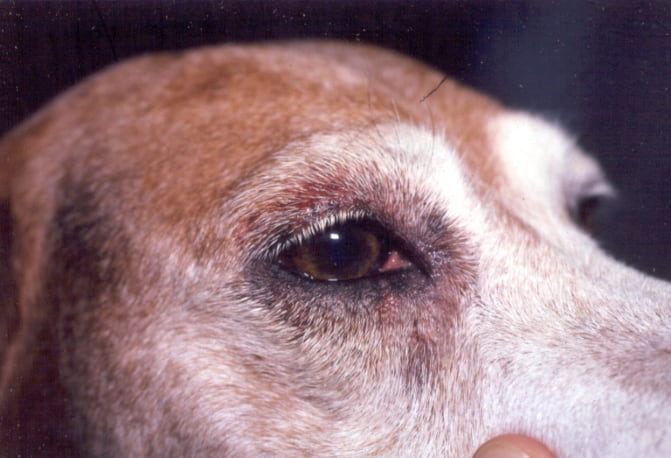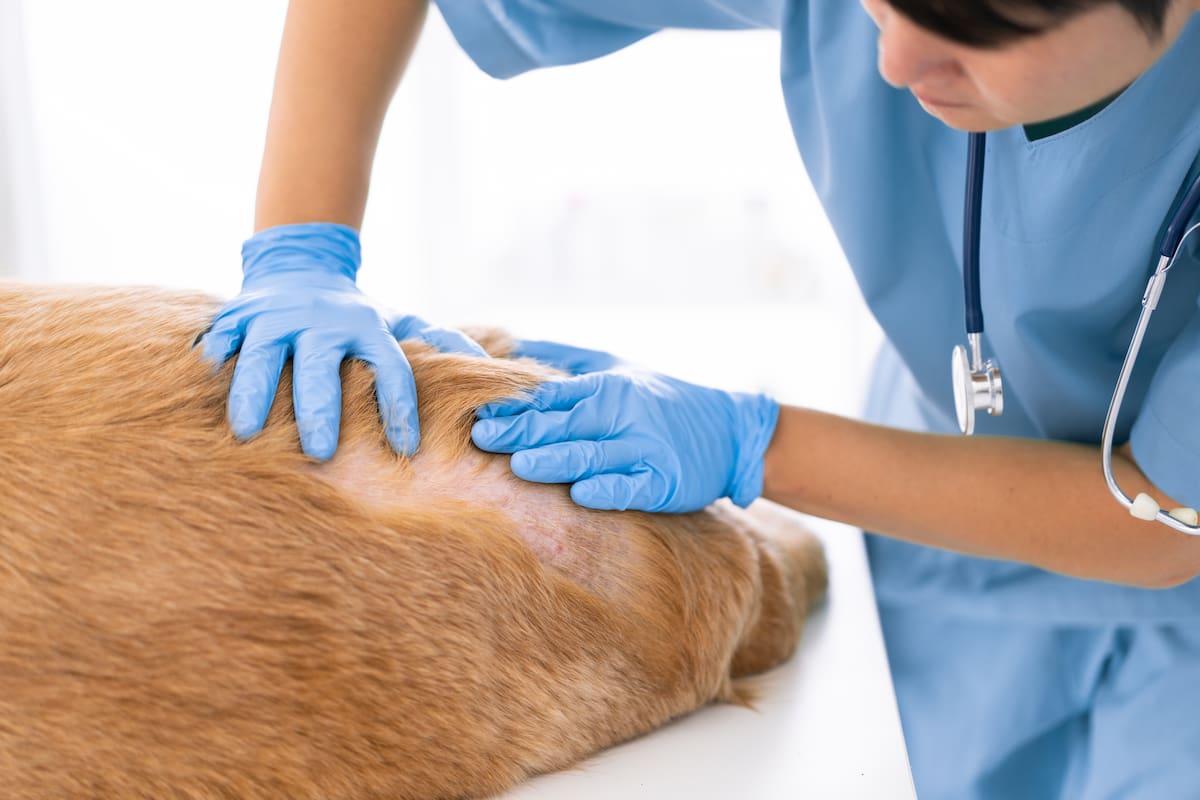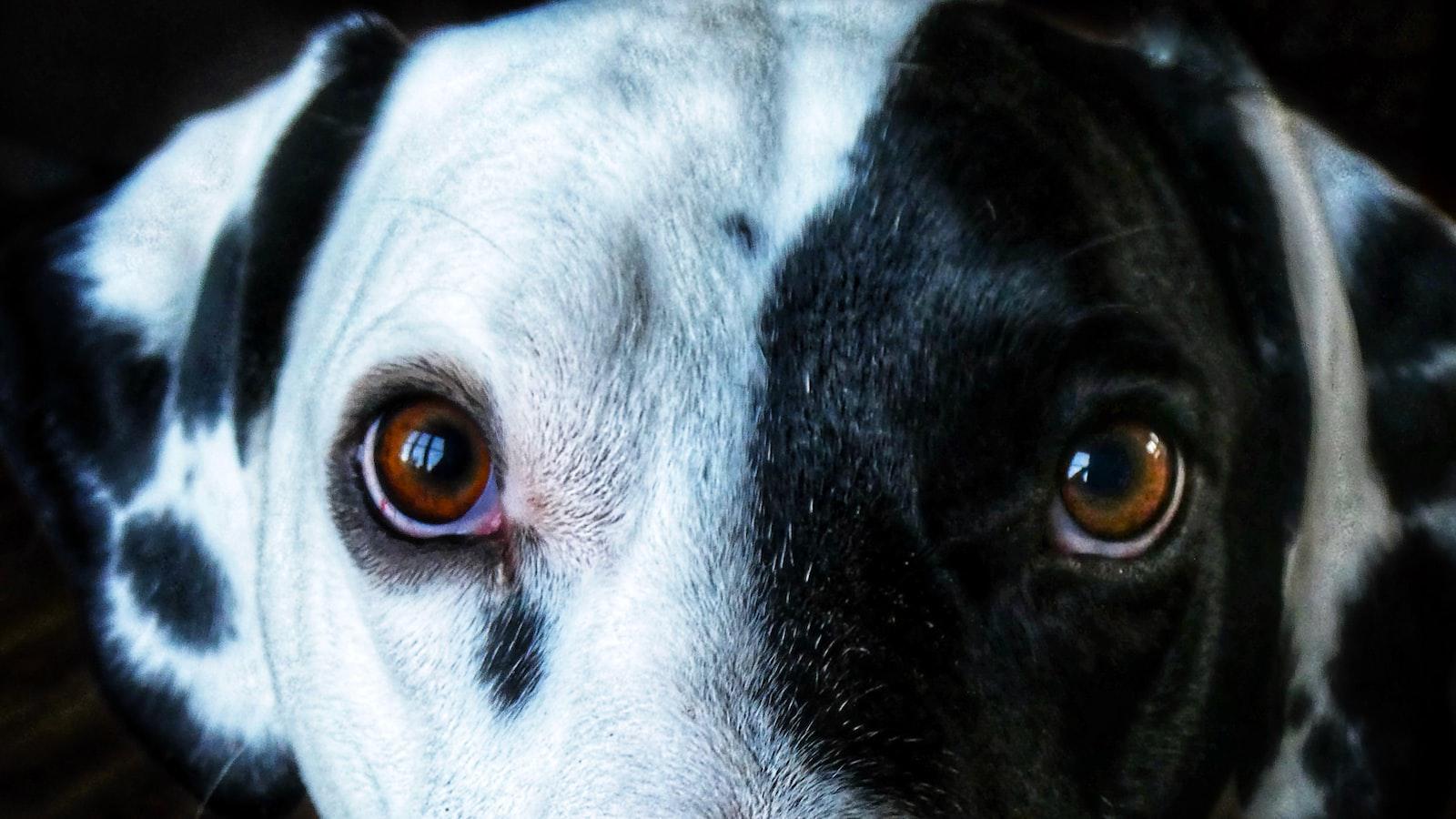Meet Rosie. She’s a 4-year-old Retriever, an absolute joy to be around.
She loves long walks in the park, playful sessions of fetch, and cuddling up on the couch during movie nights.
Recently, though, Rosie had an unusual itch which kept her scratching incessantly.
A trip to the vet revealed that she had a yeast infection, quite a common condition among dogs.
But how exactly did Rosie’s pet-parents know something was off?
And what did this yeast infection look like?
While the words “yeast infection” might conjure images straight from a science textbook, the symptoms can vary greatly in our furry friends.
Let’s dive in, comparing notes and dispensing practical insights so you’ll know what to spot, and when to seek help for your four-legged family member.
Understanding the Basics of Dog Yeast Infections
For dog owners, it’s important to know that yeast is a normal part of your furry friend’s skin and ears.
However, problems arise when this yeast starts to multiply and create an imbalance, leading to a condition popularly known as a “dog yeast infection”.
We will take a closer look at what this condition entails.
The symptoms of a dog yeast infection can vary, but there are a few key signs to look out for. These symptoms include the following:
- Itchy skin: This is often concentrated around the ears and paws, but can extend to other parts of the body.
- Unusual odors: Yeast infections can create a foul, yeasty smell that is quite distinct.
- Skin changes: You may begin to notice changes in your dog’s skin, such as discoloration, inflammation, or abnormal oilyness.
More severe cases of yeast infections in dogs can lead to symptoms like hair loss, thickened skin, and even sores from scratching.
Even though yeast infections are usually diagnosed visually, in some cases, your vet may perform a skin scraping test or a fungal culture to rule out other condition.
Also, bear in mind that yeast infections are often a sign of an underlying issue like allergies, so it is essential that you address the root of the problem and not just the symptoms to ensure the good health of your pawed friend.

Courtesy of Carol Foil
Identifying Signs and Symptoms of Yeast Infections in Dogs
Just like humans, dogs too can get yeast infections which can end up causing a range of uncomfortable symptoms.
Yeast, a type of fungi, is naturally present on the skin of dogs, however, when it overgrows, it can lead to an infection. The symptoms can be quite varied, but there are some common signs you should look out for.
Chronic scratching, licking and chewing at the body, particularly the paws, is one of the most indicative signs of a yeast infection in your dog.
These skin areas might appear red, swollen, and may sometimes lead to open sores.
This can cause your pooch significant discomfort. Other than this, your furry friend may also exhibit hair loss, thickened skin and an unpleasant odor.
Red and Itchy Skin
Yeast is most likely to overgrow in moist, humid conditions. So, common areas affected by yeast infections in your canine include their armpits, groin area, and between the toes. If you notice red, inflamed skin in these areas accompanied by chronic itching, it may be a yeast infection.
Unpleasant Smell
Yeast infections are often accompanied by a strong, foul smell. This smell is unlike your regular ‘doggy smell’ and is unique to yeast infections.
Ear Infections
If your dog appears to be in pain when touching their ears, excessively shaking their head, or has an abnormal ear odor, it might be an ear yeast infection.
Canine ear infections are often yeast-based and can cause further complications if left untreated.
Behavioral Changes are also common with dogs suffering from a yeast infection, such as a decrease in appetite, lethargy, and a change in mood.
If your dog shows any of these signs, it is essential to seek veterinary advice right away. Keep in mind, early detection and treatment is the best way to prevent further discomfort and complications for your pooch.
Examining the Causes and Risk Factors for Canine Yeast Infections
Did you know that yeast, a type of fungus, normally lives on your dog’s skin and ears without causing any issues?
However, when conditions allow the yeast to multiply unchecked, they can lead to canine yeast infections.
Let’s delve deeper into what causes this to occur.
The underlying causes of yeast infections in dogs can be quite diverse.
An immune-system response to allergies is a common one.
Diet can also play a part, as high levels of sugar in your dog’s diet can fuel yeast growth.
Certain breeds like German Shepherds and West Highland White Terriers are genetically predisposed to yeast infections.
Other potential causes include hormonal imbalances, bacterial infections, or using antibiotics that kill off too many ‘good’ bacteria which normally keep the yeast in check.
Recognizing the potential risk factors for canine yeast infections can help prevent a minor condition from turning into a major problem.
Risk factors often revolve around the overall health and lifestyle of your pet.
Dogs having a compromised immune system are at a higher risk.
Also, conditions that create a damp, humid environment, such as long, floppy ears or skin folds, can be perfect breeding grounds for yeast.
Certain medications your pet may be taking, like steroids, can also increase the chances of an infection.
Lastly, improper hygiene, such as infrequent bathing, can provide the ideal conditions for yeast growth.
Effective Treatment Methods and Home Remedies for Dog Yeast Infections
Believe it or not, your fluffy friend could get a yeast infection, just like humans.
If you’ve noticed your canine companion scratching a lot more than usual, and also suspect unusual skin odor, redness, and swelling, they might be dealing with a yeast infection.
This typically happens when your pet’s immune system is weakened and unable to keep the yeast in check, or their skin gets moist, providing a perfect environment for the yeast to multiply.
Medicated Shampoos and Ointments: One of the most common and effective methods to treat dog yeast infections are medicated shampoos and ointments.
These products contain active ingredients like miconazole or ketoconazole that help eliminate the yeast.
Enhance the effectiveness of this treatment by properly drying your pet’s skin after bathing. Never leave their ears, between the paws, or skin folds moist since these are the areas where yeast loves to thrive.
Home Remedies: Aside from medical treatments, you can also use a few home remedies to help your dog.
- Regularly cleaning and drying the affected areas of the skin is vital to prevent yeast overgrowth.
- Consider switching your pet’s diet as certain foods can contribute to yeast overproduction. A diet high in protein and low in carbohydrates is recommended.
- Probiotics are also a great option for maintaining a healthy gut flora balance, which can help prevent yeast infections from recurring.
- Topical application of diluted apple cider vinegar can help alleviate the symptoms of yeast infections. Always make sure to dilute it, as high concentrations might be harmful.
However, remember that these remedies should be used in conjunction with veterinary-approved treatments for yeast infections.
Of course, everyone would agree that the best way to deal with yeast infections in dogs is to prevent them from happening.
Regularly grooming your pet, feeding them a balanced diet, keeping them dry, and in a clean environment, can all go a long way in maintaining your dog’s overall health.
If you ever notice any signs of yeast infection, remember to act promptly.
You can always consult your pet’s vet for additional guidance and treatments.
The sooner the infection is treated, the quicker your furry friend will feel better and get back to their playful self.
Preventative Measures Against Yeast Infections
If you’re a dog owner, one common health concern you need to look out for is a yeast infection.
This pesky problem often manifests as itchy, red, and irritated skin, accompanied by a distinct foul odor.
Particularly susceptible areas on your pet include the ears, paws, armpits, and groin.
In addition to these external signs, some dogs may also show behavioral changes such as excessive scratching, shaking their head, or even scooting their bottom on the floor – signs that your pet is clearly uncomfortable.
So what can you do to prevent this unpleasant scenario? Here are some potential solutions, designed to help your pet stay healthy and yeast-free:
Maintaining a good diet: A balanced diet plays a crucial role in your dog’s overall health, including its ability to combat yeast infections. Certain foods like sugars and carbohydrates can feed the yeast, so offering a high-protein diet can help control infection.
Daily grooming: Regularly cleaning your dog, especially in areas that are prone to yeast growth, can help prevent infections. It could be as simple as keeping your dog’s paws clean and dry since moisture can promote yeast growth.
Avoiding food allergens: Some dogs may have food allergies that can weaken their immune system and make them more susceptible to yeast growth. Identifying and eliminating these allergens can help manage yeast infections.
Probiotics: Introducing probiotics to your dog’s diet can be beneficial as they can help balance the gut microbiome and discourage yeast overgrowth.
Remember, an ounce of prevention is worth a pound of cure. Establishing healthy habits in your dog’s life now can help prevent so much discomfort and distress later. As always, if you notice your pet demonstrating signs of a yeast infection, it is important to consult a veterinarian for guidance.
FAQ
Q: I keep hearing about dog yeast infections. But what exactly is a dog yeast infection?
A: A dog yeast infection is a health issue that affects your furry friend. It’s typically caused by yeast overgrowth in your pet’s body, often on their skin, ears, or even their paws. It can cause discomfort and various health problems if left untreated.
Q: How can I know if my dog has a yeast infection?
A: Yeast infections in dogs can be challenging to diagnose because the symptoms can be similar to other infections. However, some signs to look out for include itchy, red, discoloured, or smelly skin, frequent shaking of the head, excessive scratching, and even behavioural changes due to discomfort.
Q: What does a yeast infection look like on a dog’s skin?
A: When a dog has a yeast infection, their skin can often appear red, irritated, and might even be swollen. You may also notice some sores or unusual discharge. If your dog is constantly scratching, that’s another sign that something’s not right.
Q: Does a yeast infection affect only the skin?
A: Not necessarily. While the skin is a common location for a yeast infection in dogs, it’s not the only place. Dogs can also suffer from yeast infections in their ears which might cause them to frequently shake their heads or scratch their ears. Some dogs might also get yeast infections between their paws.
Q: If my dog has these symptoms, does it mean they surely have a yeast infection?
A: While these symptoms are typical for a yeast infection, they could also indicate other health issues. Therefore, it’s crucial to take your dog to the vet to get a proper diagnosis.
Q: How can I prevent my dog from getting a yeast infection?
A: There are some steps you can take to prevent yeast infections in dogs. That includes maintaining their overall health through a balanced diet and regular exercise, keeping them clean and dry, and regular vet checkups.
Q: What happens if a yeast infection is left untreated in dogs?
A: If left untreated, a yeast infection can cause severe discomfort for your dog. It can lead to constant scratching, which can, in turn, lead to more skin issues, including sores and infections. It can also cause behavioural changes due to the constant discomfort. So, it’s crucial to get it diagnosed and treated as soon as possible.
Q: How do vets prescribe treatment for this condition?
A: Treatment can range from topical creams to oral medicines, depending on the severity and location of the infection. Most often, it will involve specific anti-yeast medications to kill the overgrowth, followed by measures to restore the skin’s normal microbiome. Your vet will tell you all the steps you need to follow.
Q: Can I do anything else to support my dog through this treatment?
A: Absolutely! Apart from the medical treatment, ensuring that your dog is stress-free and getting all the love, care, and good diet it needs also goes a long way in promoting their recovery. Regular grooming habits will help as well.
Q: That’s a lot of information. Anything else I should know?
A: Always remember that prevention is better than cure. With healthy habits, cleanliness, and regular vet check-ups, you can prevent a lot of health issues, including yeast infections, in dogs.
Q: Great! Thanks for all your advice.
A: You’re welcome! We’re always here to help you take care of your furry friend.
Insights and Conclusions
In conclusion, identifying a yeast infection in dogs is not as complex as it might seem initially.
By keeping an eye out for symptoms like itchy, discolored, or smelly skin, you can seek prompt veterinary help for your furry friend.
Remember, prevention is always better than cure. So whether it’s a quick ear check after playtime or maintaining a balanced diet for your pet, every bit counts when it comes to their health.
After all, having a happy, healthy four-legged companion bounding around the house makes your home a happier place too.
Don’t hesitate to consult a vet if you notice anything amiss. In the end, it’s all about giving our canine compadres the best life possible.













